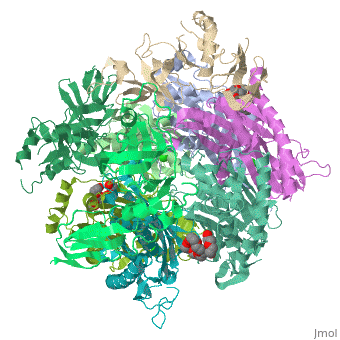Exosome: Difference between revisions
Michal Harel (talk | contribs) No edit summary |
Michal Harel (talk | contribs) No edit summary |
||
| Line 2: | Line 2: | ||
<StructureSection load='2je6' size='340' side='right' caption='Exosome complex containing exonuclease 1 (green), exonuclease 2 (grey) and exosome complex RNA-binding protein 1 (wheat) complex with PEG400 (pdb code [[2je6]]).' scene=''> | <StructureSection load='2je6' size='340' side='right' caption='Exosome complex containing exonuclease 1 (green), exonuclease 2 (grey) and exosome complex RNA-binding protein 1 (wheat) complex with PEG400 (pdb code [[2je6]]).' scene=''> | ||
The '''Exosome complex''' (or just- Exosome) is a multi-protein complex capable of degrading various types of RNA molecules. The Exosome complex is found in eukaryotic cell, and also in archaea, while in bacteria it is found as a simpler complex (but it has the same function). <ref>http://en.wikipedia.org/wiki/Exosome_complex#Structure</ref> | The '''Exosome complex''' (or just- Exosome) is a multi-protein complex capable of degrading various types of RNA molecules. The Exosome complex is found in eukaryotic cell, and also in archaea, while in bacteria it is found as a simpler complex (but it has the same function). <ref>http://en.wikipedia.org/wiki/Exosome_complex#Structure</ref> | ||
Some of the exosome components are:<br /> | |||
*'''MTR3''' which is part of RNase PH domain-containing subunits proposed to form a central channel which threads RNA for degradation.<br /> | |||
*'''MTR4''' interacts with Nop53 and together they have a role in the maturation of 5.8S rRNA. | |||
__TOC__ | __TOC__ | ||
Revision as of 12:01, 25 June 2019
ExosomeExosome
The Exosome complex (or just- Exosome) is a multi-protein complex capable of degrading various types of RNA molecules. The Exosome complex is found in eukaryotic cell, and also in archaea, while in bacteria it is found as a simpler complex (but it has the same function). [1] Some of the exosome components are:
FunctionIn order to see the structure of the protein complex, press . Enzymatic functionThe exosome is primarily a 3'-5' exoribonuclease, meaning that it degrades RNA molecules from their 3' end. In eukaryotes it also have an endoribonucleolytic function, meaning it cleaves RNA at sites within the molecule. SubstratesThe exosome is involved in the degradation and processing of a wide variety of RNA species. Substrates of the exosome include messenger RNA, ribosomal RNA, and many species of small RNAs. DiseaseAutoimmunityThe exosome complex is the target of autoantibodies, which are known to be found in people that suffer from various autoimmune diseases (especially PM/Scl overlap syndrome). In the autoimune diseases, antibodies are mainly directed against two of the proteins of the complex, called PM/Scl-100 and PM/Scl-75. Cancer treatmentThe Exosome is found to be inhibited by a cancer chemotherapy drug, which called antimetabolite fluorouracil. This drug is one of the most successful drugs for treating solid tumors. Neurological disordersMutations in Exosome component 3 cause pontocerebellar hypoplasia and spinal motor neuron disease. Structural highlightsThe central machinery of exosome is shaped like a , with its RNA cleavage machinery sheltered in a groove inside. The core of the Exosome complex is made of a ring, which is consisting of six RNases proteins (Rnase PH-like proteins), and other proteins are attached. You can also view the complex in a . 3D structures of exosome
|
| ||||||||||
